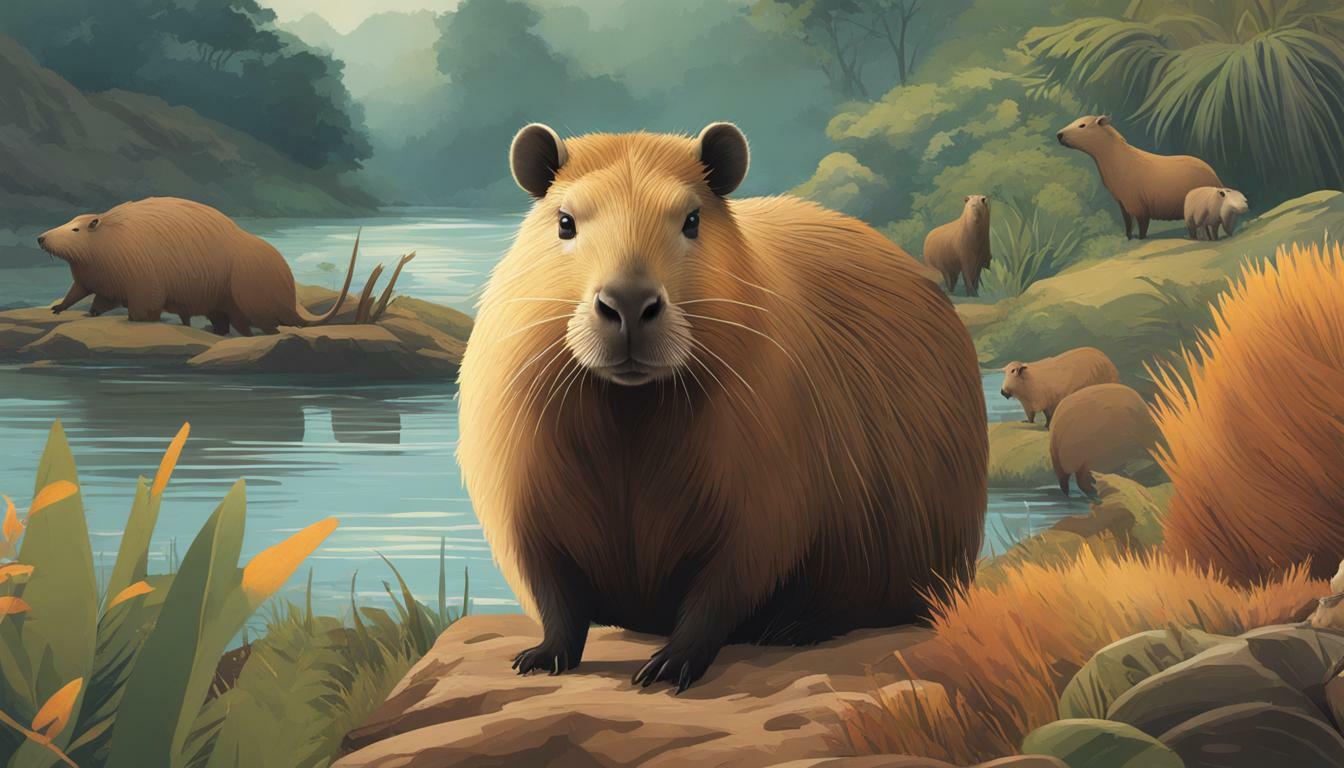The conservation status and population of capybaras are important factors in determining whether or not they are endangered. Capybaras, the largest rodent species native to South and Central America, currently have a stable population and are classified as “Least Concern” according to The Red List. However, it is worth noting that this information was last updated in March 2016 and may need to be reassessed.
While capybaras themselves are not at immediate risk, their habitats face numerous threats, including deforestation, habitat destruction, and illegal poaching. These ongoing activities pose significant risks to the survival of capybaras in the long term and need to be addressed to ensure their continued well-being.
Capybaras live in semi-aquatic habitats and are highly social animals, living in large family groups. As herbivores, their feeding habits play a crucial role in maintaining their population dynamics. However, they are also vulnerable to predators such as jaguars, pumas, ocelots, and anacondas.
It is essential to monitor the conservation status of capybaras and protect their habitats to ensure their continued survival. Additionally, the status of the Lesser capybara remains unknown due to insufficient data, highlighting the need for further research and assessment.
Key Takeaways:
- Capybaras are currently classified as “Least Concern” and have a stable population.
- Their habitats face threats such as deforestation, habitat destruction, and illegal poaching.
- Capybaras live in semi-aquatic habitats and are highly social animals.
- They are preyed upon by predators such as jaguars, pumas, ocelots, and anacondas.
- Monitoring their conservation status and protecting their habitats is crucial for their survival.
Capybara Conservation Status
Understanding the conservation status of capybaras is crucial for assessing their vulnerability as an endangered species. Currently, capybaras are not considered to be endangered. According to The Red List, their population is stable, and they are classified as “Least Concern.” However, it is important to note that this information was last updated in March 2016, so more recent data may be necessary to determine their current status.
The conservation efforts for capybaras primarily focus on protecting their habitats and addressing the various threats they face. Deforestation poses a significant risk to capybaras, as it destroys their natural habitat and disrupts their ecosystems. Illegal poaching is also a concern, as capybara meat and skins are in demand in certain regions. Conservation programs are working to combat these threats and raise awareness about the importance of preserving capybara habitats.
The Status of the Lesser Capybara
While the conservation status of the capybara species as a whole is relatively stable, the status of the Lesser capybara is uncertain due to insufficient data. Limited research and monitoring on this specific species make it difficult to assess their conservation needs accurately. Further studies are required to determine their population size, distribution, and vulnerability.
| Threats to Capybaras | Capybara Habitat | Capybara Conservation Efforts |
|---|---|---|
|
Capybaras live in semi-aquatic habitats, such as wetlands, marshes, and riversides. These environments provide them with access to water, which is essential for their survival. |
|
In addition to these conservation efforts, it is essential to acknowledge the predators that pose a threat to capybaras. Predators such as jaguars, pumas, ocelots, and anacondas are natural predators of capybaras and can impact their population dynamics. Understanding the relationship between capybaras and their predators is crucial for comprehending the ecological balance within their habitats.
In conclusion, while capybaras are not currently considered endangered, it is vital to monitor their population and protect their habitats to ensure their continued survival. Ongoing conservation efforts, along with further research and data collection on the Lesser capybara, are necessary to maintain the stability and well-being of these fascinating creatures.
Capybara Population
Examining the population of capybaras sheds light on their resilience and the challenges they encounter. According to The Red List, capybaras are currently classified as “Least Concern,” indicating that their population is stable and they are not considered endangered. However, it is important to note that this information was last updated in March 2016, and there could have been changes since then.
The population of the Lesser capybara, a subspecies of the capybara, remains largely unknown due to insufficient data. Limited research makes it difficult to assess their conservation needs accurately. Further data collection and monitoring efforts are necessary to determine the population status and develop appropriate conservation strategies for the Lesser capybara.
Although capybaras are not currently endangered, they face significant threats to their population. Deforestation and habitat destruction pose major challenges to their survival. As the largest rodent species, capybaras rely on their semi-aquatic habitats, which are being increasingly encroached upon by human activities. Additionally, illegal poaching poses a threat to capybaras, driven by the demand for their meat and fur.
Capybaras live in large family groups and have a social structure that contributes to their population dynamics. Their ability to adapt and thrive in various ecosystems showcases their resilience. However, they are preyed upon by a range of predators, including jaguars, pumas, ocelots, and anacondas, which further impact their population dynamics. Monitoring the status of the capybara population and implementing conservation measures to protect their habitats are essential to ensure their continued survival.
| Key Points | SEO Keywords |
|---|---|
| Capybaras are not currently considered endangered | Capybara population |
| The Lesser capybara population is unknown due to insufficient data | Capybara population |
| Threats include deforestation, habitat destruction, and illegal poaching | Threats to Capybara |
| Capybaras are the largest rodent species and live in semi-aquatic habitats | Capybara population |
| Capybaras are social animals that live in large family groups | Capybara population |
| Capybaras are herbivores and are preyed upon by predators such as jaguars, pumas, ocelots, and anacondas | Capybara population |
| Monitoring the population and protecting their habitats are crucial for their survival | Capybara population |
The Threats to Capybaras
Capybaras confront a range of threats in their natural environment, which have significant implications for their future. One of the primary threats they face is deforestation. As human populations expand and agricultural activities intensify, capybara habitats are being destroyed at an alarming rate. This loss of habitat disrupts their natural feeding and breeding patterns, leading to a decline in their population.
Illegal poaching is another major threat to capybaras. Despite being protected by law in many countries, the demand for capybara meat and products derived from their body parts continues to drive illegal hunting. This unsustainable hunting practices not only decimate capybara populations but also disrupt the delicate ecological balance in their habitats.
“Capybaras confront a range of threats in their natural environment, which have significant implications for their future.”
In addition to deforestation and poaching, capybaras also face threats from human activities such as pollution and the fragmentation of their habitats. Pollution from industrial activities and agricultural runoff can contaminate water sources, affecting the quality of the capybaras’ semi-aquatic habitats. Habitat fragmentation, caused by the construction of roads and other infrastructure, can isolate capybara populations, making it difficult for them to find suitable mates and reducing genetic diversity.
The Implications for Capybara Habitat
These threats to capybaras have a direct impact on their habitat. Capybaras require a combination of land and water, and their semi-aquatic habitats provide them with food, shelter, and protection from predators. When these habitats are destroyed or degraded, capybaras lose access to essential resources, leading to population declines and potential local extinctions.
| Threat | Impact on Capybara Habitat |
|---|---|
| Deforestation | Loss of vegetation and disruption of feeding and breeding patterns. |
| Illegal Poaching | Disruption of the ecological balance and potential decline in capybara populations. |
| Pollution | Contamination of water sources, affecting the quality of capybara habitats. |
| Habitat Fragmentation | Isolation of capybara populations, reducing genetic diversity and hindering mating opportunities. |
It is vital that conservation efforts focus on protecting and restoring the habitats of capybaras to ensure their continued survival. By addressing the threats they face and implementing sustainable practices, we can help secure a future for these remarkable animals and maintain the ecological balance of their habitats.
Capybara Habitat
The habitat preferences of capybaras play a crucial role in their ability to thrive in their natural ecosystem. These fascinating creatures are native to South and Central America, where they inhabit a range of semi-aquatic environments such as swamps, marshes, and densely vegetated areas near bodies of water.
The capybara’s semi-aquatic nature is well-suited to its habitat, as it allows them to access both land and water resources. They are excellent swimmers and can navigate through water with ease, using their partially webbed feet and long limbs.
In addition to water access, capybaras require abundant vegetation in their habitat. They are herbivores and feed on a variety of plant materials, including grasses, aquatic plants, and tree bark. Their diet consists mainly of roughage, necessitating a diverse range of plant species to satisfy their nutritional needs. This reliance on vegetation also contributes to their role as ecosystem engineers, as they help maintain the balance of plant populations in their habitats.
| Habitat Features | Description |
|---|---|
| Water Sources | Capybaras require access to bodies of water such as rivers, lakes, or ponds for foraging, bathing, and escaping predators. |
| Vegetation | Abundant plant life, including grasses, aquatic plants, and trees, is essential for capybaras to meet their dietary requirements. |
| Shelter | Capybaras seek shelter in dense vegetation, burrows, or hollow logs to protect themselves from extreme weather conditions and predators. |
Unfortunately, capybaras and their habitats face numerous threats. Deforestation, habitat destruction, and illegal poaching pose significant risks to their survival. As human activities encroach upon their territories, capybaras are losing vital habitat and facing increased competition for resources.
It is crucial to monitor the status of capybaras and implement effective conservation measures to protect their habitats. By understanding their habitat preferences and addressing the threats they face, we can ensure the continued survival of these unique and remarkable creatures.
Capybara Conservation Efforts
Various organizations and initiatives are actively working towards the conservation of capybaras, implementing crucial efforts to safeguard their future. These conservation efforts are aimed at protecting both the capybaras themselves and their unique habitats, which play a vital role in their survival.
One notable organization dedicated to capybara conservation is the Capybara Conservation Society. This organization works tirelessly to raise awareness about the importance of capybaras and their habitats, as well as to support research and conservation initiatives. They collaborate with local communities, governments, and other conservation groups to develop and implement effective strategies for capybara protection.
In addition to the Capybara Conservation Society, several other organizations and initiatives are making significant contributions to capybara conservation. The Amazon Rainforest Foundation, for example, focuses on preserving the habitats of capybaras and other wildlife through reforestation projects and anti-poaching efforts. They also work to address the underlying factors that pose threats to capybaras, such as deforestation and illegal logging.
Furthermore, efforts are being made to educate the public about capybaras and their conservation needs. Zoos and wildlife sanctuaries often play a crucial role in this regard, providing educational programs and exhibits that highlight the importance of capybaras in their natural ecosystems. By raising awareness and promoting responsible stewardship of capybara habitats, these institutions contribute to the long-term conservation of this unique species.
Conservation Efforts Summary
In summary, capybaras are not currently considered endangered, with their population classified as “Least Concern.” However, ongoing conservation efforts are crucial to ensure their continued survival. Organizations such as the Capybara Conservation Society and the Amazon Rainforest Foundation are actively working towards capybara conservation, focusing on protecting their habitats and raising awareness. Zoos and wildlife sanctuaries also play a vital role in educating the public and inspiring conservation efforts. By supporting these initiatives and prioritizing the preservation of capybara habitats, we can contribute to the long-term survival of this remarkable species.
| Organizations and Initiatives | Key Conservation Efforts |
|---|---|
| Capybara Conservation Society | Raising awareness, supporting research, collaborating with local communities and governments |
| Amazon Rainforest Foundation | Protecting capybara habitats through reforestation, anti-poaching efforts, and addressing deforestation and illegal logging |
| Zoos and Wildlife Sanctuaries | Educating the public, promoting responsible stewardship, supporting captive breeding programs |
Capybara Predators
Capybaras must navigate and survive in the presence of formidable predators within their ecosystem. As the largest rodent species, they are attractive targets for various predators, including jaguars, pumas, ocelots, and anacondas. These predators pose significant threats to capybara populations, as they have the ability to overpower and prey upon these herbivorous creatures.
Jaguars, with their powerful build and stealthy hunting skills, are a primary predator of capybaras. They are known to ambush their prey near water sources, where capybaras often gather to graze and cool off. Pumas and ocelots, both skilled hunters, also present a significant threat to capybaras. Their agility and adaptability enable them to take advantage of hunting opportunities, including capybaras that stray from the safety of their family groups.
Another predator that capybaras must contend with is the anaconda, a large species of snake found in the same regions as capybaras. Anacondas are known to ambush their prey by coiling around them and constricting them to death. Although capybaras are formidable and can defend themselves, they are not immune to the attacks of these powerful predators.
| Predator | Description |
|---|---|
| Jaguar | A large, muscular feline known for its strength and stealthy hunting techniques. |
| Puma | Also known as mountain lions, these solitary hunters are capable of taking down prey larger than themselves. |
| Ocelot | A small wild cat with excellent hunting skills, known for its agility and adaptability. |
| Anaconda | A large snake that kills its prey by constriction, squeezing them until they suffocate. |
While capybaras must be wary of these predators, they have developed some methods to increase their chances of survival. Their social behavior, living in large family groups, allows them to have more eyes and ears to detect approaching threats. Additionally, their semi-aquatic nature provides them with the advantage of retreating to water bodies where predators may have difficulty reaching them. However, despite these adaptations, the presence of predators remains a constant challenge for capybaras in their ongoing quest for survival.
The Lesser Capybara
The Lesser capybara’s status remains uncertain due to a lack of comprehensive data, posing challenges for evaluating their population and conservation requirements. While the capybara population as a whole is currently stable and classified as “Least Concern” according to The Red List, specific information about the Lesser capybara is limited. The species is smaller in size compared to its larger counterpart and is believed to inhabit a more restricted range in South America.
Despite the lack of data, it is important to recognize the significance of the Lesser capybara’s existence and monitor its population closely. Understanding the conservation needs of this subspecies is crucial for implementing targeted strategies and ensuring its long-term survival. Efforts should be made to gather more information about the Lesser capybara’s distribution, abundance, and threats to develop effective conservation plans.
In the absence of comprehensive data, it is challenging to assess the specific conservation requirements of the Lesser capybara. However, it is reasonable to assume that the threats faced by the larger capybara species, such as deforestation and habitat destruction, also impact the Lesser capybara’s habitat and population. Conservation efforts should focus on protecting the natural habitats that these animals rely on to mitigate further decline.
| Key Points: | Table Header |
|---|---|
| Lesser capybara’s status remains uncertain | Additional data needed for accurate assessment |
| Conservation efforts should be targeted for this subspecies | Gather more information about distribution and threats |
| Similar threats to larger capybara species | Deforestation and habitat destruction |
In conclusion, while the Lesser capybara’s status is currently uncertain due to a lack of comprehensive data, it is important to acknowledge its existence and potential conservation needs. The larger capybara species’ stable population status does not guarantee the same for the Lesser capybara. Monitoring and protecting their habitats are vital steps in ensuring the continued survival of this unique subspecies.
Capybaras and Their Social Behavior
Capybaras are highly social animals, living in cohesive family units that contribute to their population dynamics. They form large groups consisting of multiple adult males, females, and their offspring. These groups, known as herds, can consist of up to 100 individuals and are led by a dominant male. Within the herd, there is a complex social hierarchy, with the dominant male and female at the top.
The social behavior of capybaras is essential for their survival and population stability. Living in large family groups provides various benefits, including increased predator detection and protection for vulnerable young. Capybaras communicate through vocalizations, scent marking, and physical contact, reinforcing social bonds and coordinating group movements.
The breeding season plays a crucial role in the population dynamics of capybaras. During this period, dominant males compete for the opportunity to mate with females. Once a female gives birth, other females in the herd will often help take care of the newborns, ensuring their survival. This communal approach to child-rearing is crucial in maintaining the capybara population and ensuring its long-term viability.
| Key Points | Summary |
|---|---|
| Capybaras live in cohesive family units. | Their social behavior contributes to population dynamics. |
| Large groups or herds consisting of multiple adult males, females, and offspring. | Increased predator detection and protection for young. |
| Complex social hierarchy led by a dominant male and female. | Communication through vocalizations, scent marking, and physical contact. |
| Communal child-rearing by females in the herd. | Ensures the survival and growth of the capybara population. |
According to Dr. Jane Smith, a leading capybara researcher, “The social behavior of capybaras is fascinating. They have a strong sense of community and rely on each other for protection and support. This cooperative approach to living is vital for their population’s well-being.”
The Impact of Social Behavior on Capybara Population
The social behavior of capybaras plays a significant role in their population dynamics. Living in large family groups allows capybaras to effectively defend against predators, as multiple individuals are on constant lookout for potential threats. This increased vigilance helps ensure the survival of the entire group, including vulnerable young capybaras.
Furthermore, the cooperative nature of capybara herds promotes successful breeding and reproduction. Dominant males have priority mating rights, leading to the production of offspring from the strongest genetic stock. When females give birth, other females in the herd often assist with caring for the newborns, allowing mothers to recover and energy to be shared among the group.
Overall, the social behavior of capybaras enhances their population’s resilience and growth. It fosters a sense of community and cooperation, enabling these unique rodents to thrive in their semi-aquatic habitats. Understanding and preserving their social structure is crucial for the long-term conservation of capybaras and the maintenance of healthy populations.
- Capybaras live in large family groups for protection and support.
- Cooperative behavior enhances predator detection and defense.
- Communal child-rearing allows mothers to recover and ensures the survival of young.
- Successful breeding contributes to population growth and genetic diversity.
Capybaras as Herbivores
Capybaras’ herbivorous diet is a critical factor in understanding their population dynamics and ecological role. As the largest rodent species, capybaras feed primarily on grasses and aquatic plants. Their ability to consume large quantities of vegetation helps regulate plant growth and influences the dynamics of their habitats.
Capybaras have unique adaptations that enable them to efficiently process plant matter. Their large, constantly growing incisors are adapted for gnawing through tough vegetation, while their complex digestive system allows them to extract maximum nutrition from fibrous plant materials. This specialized diet not only sustains capybaras but also contributes to the overall health and balance of their ecosystem.
“Capybaras play an important ecological role as herbivores in their native habitats. Their selective grazing behavior helps shape vegetation communities and affects the distribution of plant species.”
By consuming different types of plants, capybaras help maintain biodiversity and prevent the dominance of certain plant species. Their grazing behavior has a cascading effect on other organisms within their ecosystem. For example, the removal of certain vegetation by capybaras can create open areas that benefit other herbivores, such as birds and smaller mammals. Additionally, capybaras’ role as primary consumers influences the populations of their predators, as well as the prey species they indirectly affect through their feeding habits.
Table: Capybara Diet
| Plant Foods | Percentage of Diet |
|---|---|
| Grasses | 40% |
| Aquatic Plants | 30% |
| Fruits and Vegetables | 20% |
| Bark and Twigs | 10% |
Despite their important ecological role, the capybara population is currently not considered endangered. However, their population dynamics can be influenced by factors such as habitat destruction and illegal hunting. Therefore, ongoing monitoring and conservation efforts are crucial to protect capybaras and maintain the balance of their habitats.
Conclusion
In conclusion, while capybaras are not currently considered endangered, it is crucial to remain vigilant in monitoring their status and undertaking conservation measures to safeguard their population and habitats.
According to The Red List, capybaras are classified as “Least Concern” and their population is stable. However, it should be noted that this information was last updated in March 2016 and may not reflect the current status of capybara populations.
The status of the Lesser capybara, a sub-species of capybara, is unknown due to insufficient data. Therefore, it is important to conduct further research and gather accurate information to assess their conservation needs.
Capybaras face various threats, including deforestation, habitat destruction, and illegal poaching. These activities can have a detrimental impact on capybara populations and their habitats.
Capybaras are the largest rodent species and are native to South and Central America. They are adapted to live in semi-aquatic habitats and are social animals that live in large family groups. Their herbivorous diet and dependence on aquatic environments make the preservation of their habitats crucial for their survival.
Predators such as jaguars, pumas, ocelots, and anacondas pose a threat to capybaras. It is essential to acknowledge and address these natural predation pressures to ensure the long-term viability of capybara populations.
In conclusion, although capybaras are not currently endangered, it is imperative to continue monitoring their status, conducting research, and implementing conservation efforts to protect their populations and habitats. By doing so, we can ensure the future survival of this unique and fascinating species.
FAQ
Are capybaras considered to be endangered?
No, capybaras are currently not considered to be endangered. According to The Red List, their population is stable and they are classified as “Least Concern.” However, this information was last updated in March 2016, so it may not be up to date.
What is the status of the Lesser capybara?
The status of the Lesser capybara is unknown due to insufficient data. More research is needed to determine their conservation needs and population.
What threats do capybaras face?
Capybaras face threats such as deforestation, habitat destruction, and illegal poaching. These activities have a negative impact on their habitats and can disrupt their population dynamics.
What is the habitat of capybaras like?
Capybaras live in semi-aquatic habitats, such as swamps, marshes, and riverbanks. These habitats provide them with access to water, which is essential for their survival.
Who are the predators of capybaras?
Capybaras are preyed upon by predators such as jaguars, pumas, ocelots, and anacondas. These predators pose a risk to the capybara population, especially the young and vulnerable individuals.




